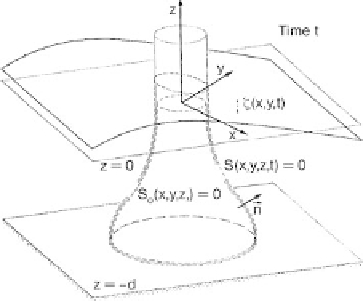Environmental Engineering Reference
In-Depth Information
Fig. 2.43 De
nitions for the non-linear potential theory problem
- non-linear restoring forces,
- hydrodynamic impacts (slamming),
- movements of fluids in partially filled spaces (sloshing),
- and so on.
A brief introduction to the non-linear potential theory problem of the interaction
between wave and structure is given below.
If the exciting wave can no longer be represented with good approximation according
to Airy, then higher-order potential theory solutions must be used to ascertain the
interaction between structure and wave. A number of the fundamental assumptions
of linear theory are no longer permissible in such a non-linear concept. This will
be illustrated here by formulating the non-linear boundary value problem using the
example of a structure erected on the seabed (Figure 2.43).
The wetted surfaces for still water (S
0
) and in the wave field (S) at time t are described by
S
0
ð
x
;
y
;
z
;
t
Þ¼
0
and S
ð
x
;
y
;
z
;
t
Þ¼
0
The surface of the water outside the structure is taken as
z ¼ z
ð
x
;
y
;
t
Þ
The Laplace differential equation has to be satisfied throughout the entire flow field:
DF ¼
0
The result is the following boundary conditions:
a) The kinematic boundary condition on the seabed
@F
@
z
¼
0
for
z
¼
d



